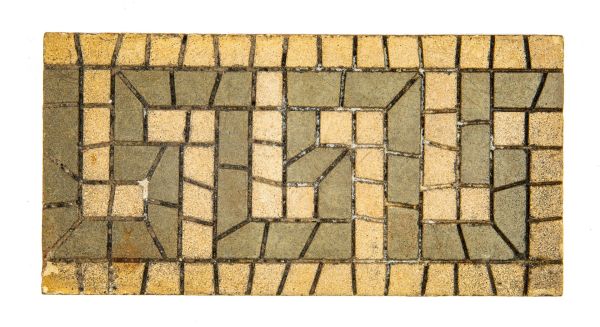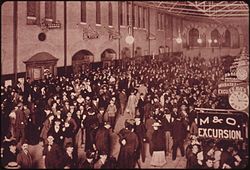original 19th century mosaic 3 x 6 inch lobby floor border tile salvaged from theodore link's st. louis union station
Union Station (St. Louis)
|
St. Louis Union Station
|
||
|---|---|---|

Main facade and plaza featuring Carl Milles' fountain sculpture Meeting of the Waters
|
||
| General information | ||
| Location | 1820 Market Street St. Louis, Missouri |
|
| Owned by | Lodging Hospitality Management | |
| Platforms | 3 island platforms | |
| Tracks | 4 (used for excursions) | |
| Connections |
|
|
| Construction | ||
| Parking | Yes | |
| Accessible | Yes | |
| History | ||
| Opened | 1894 | |
| Closed | 1978 | |
| Rebuilt | 1985 (mall) 2019 (aquarium) |
|
|
||
|
St. Louis Union Station
|
||

|
||
| Coordinates | 38°37′40.9″N 90°12′28.34″WCoordinates: 38°37′40.9″N 90°12′28.34″W | |
| Built | 1892-94 | |
| Architect | Theodore Link | |
| Architectural style | Romanesque Revival | |
| NRHP reference No. | 70000888[1] | |
| Significant dates | ||
| Added to NRHP | June 15, 1970 | |
| Designated NHL | December 30, 1970[2] | |
St. Louis Union Station is a National Historic Landmark and former train station in St. Louis, Missouri. At its 1894 opening, the station was the largest in the world that had tracks and passenger service areas all on one level. Traffic peaked at 100,000 people a day in the 1940s.[3] The last Amtrak passenger train left the station in 1978.
In the 1980s, it was renovated as a hotel, shopping center, and entertainment complex. The 2010s and 2020s saw more renovation and expansion of entertainment and office capacity. The current hotel portion of the station is currently a member of Historic Hotels of America, the official program of the National Trust for Historic Preservation.[4]
An adjacent station serves the light-rail MetroLink Red and Blue Lines, which run under the station in the Union Station subway tunnel. The city's intercity train station sits a quarter-mile to the south, serving MetroLink, Amtrak, and Greyhound Bus.
History
19th century
The station was opened on September 1, 1894, by the Terminal Railroad Association of St. Louis. The station was designed by Theodore Link, and included three main areas: the Headhouse and the Midway, and the 11.5-acre (47,000 m2) Train Shed designed by civil engineer George H. Pegram.[5] The headhouse originally housed a hotel, a restaurant, passenger waiting rooms and railroad ticketing offices. It featured a gold-leafed Grand Hall, Romanesque arches, a 65-foot (20 m) barrel-vaulted ceiling and stained-glass windows. The clock tower is 230 feet (70 m) high.[6]
Union Station's headhouse and midway are constructed of Indiana limestone and initially included 32 tracks under its vast trainshed terminating in the stub-end terminal. Its Grand Hall, which cost around $6.5 million and was about 75 by 125 feet large, was considered to be one of the most beautiful public lobbies.[citation needed]
At its opening, it was the world's largest and busiest railroad station and its trainshed was the largest roof span in the world.[citation needed]
20th century
In 1903, Union Station was expanded to accommodate visitors to the 1904 St. Louis World's Fair.[7] In the 1920s, it remained the largest American railroad terminal.[8]
At its height, the station combined the St. Louis passenger services of 22 railroads, the most of any single terminal in the world. In the 1940s, it handled 100,000 passengers a day.[3] The famous photograph of Harry S. Truman holding aloft the erroneous Chicago Tribune headline, "Dewey Defeats Truman", was shot at the station as Truman headed back to Washington, D.C., from Independence, Missouri, after the 1948 Presidential election.
The 1940s expansion added a new ticket counter designed as a half-circle and a mural by Louis Grell could be found atop the customer waiting area which depicted the history of St. Louis with an old fashion steam engine, two large steamboats and the Eads Bridge in the background.
As airliners became the primary mode of long-distance travel and railroad passenger services declined in the 1950s and 1960s, the massive station became obsolete and too expensive to maintain for its original purpose. By 1961, several tracks had been paved over for parking. Amtrak took over passenger service in 1971, but abandoned Union Station on October 31, 1978. By then, Amtrak had cut back service to four routes per day–the State House, the Ann Rutledge, the National Limited (formerly the Spirit of St. Louis) and the Inter-American. The eight total trains were nowhere near enough to justify the use of such a large facility. The last train to leave Union Station was a Chicago-bound Inter-American. Passenger service shifted to a temporary-style "Amshack" two blocks east. Amtrak has since moved its St. Louis service to the Gateway Transportation Center, one block east of Union Station.[7][9]
The station was designated a National Historic Landmark in 1970, as an important surviving example of large-scale railroad architecture from the late 19th century.[10] It was designated as a National Historic Civil Engineering Landmark by the American Society of Civil Engineers in 1981.[11]
In August 1985, after a $150 million renovation designed by HOK, Union Station was reopened with a 539-room hotel, shopping mall, restaurants and food court. Federal historic rehabilitation tax credits were used to transform Union Station into one of the city's most visited attractions. The station rehabilitation by Conrad Schmitt Studios[12] remains one of the largest adaptive re-use projects in the United States. The hotel is housed in the headhouse and part of the train shed, which also houses a lake and shopping, entertainment and dining establishments. Omni Hotels was the original hotel operator, followed by Hyatt Regency Hotel chain and Marriott Hotels.
WORDLWIDE SHIPPING
If required, please contact an Urban Remains sales associate.
NEW PRODUCTS DAILY
Check back daily as we are constantly adding new products.
PREMIUM SUPPORT
We're here to help answer any question. Contact us anytime!
SALES & PROMOTIONS
Join our newsletter to get the latest information




























